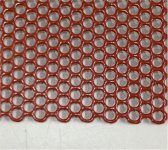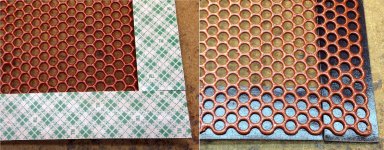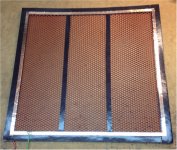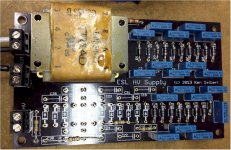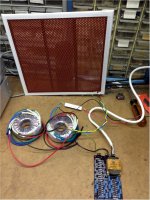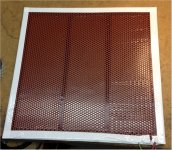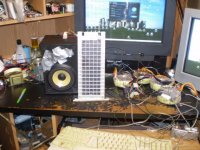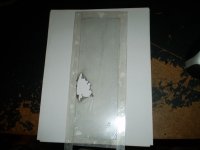I have started down the road of constructing my first ESL system. I used an insulating lacquer paint on the 12"x12" panels and they passed the "spark test" with no issues. Used double sided foam tape 1/16" as the spacer, 6um mylar tensioned to 1.5% using a bicycle tire stretcher. Using Antec toroidal transformers and a HV supply board I designed (multiple taps for varying HV supply voltages). Using Licron spray as the coating.
The whole thing went together over the course of a couple of weeks, thanks mostly to the loads of useful advice on this forum. I had some issues along the way with too much Licron, then overtensioning the mylar, then a couple wrinkles in the mylar. These things happen, no big deal, clean off the panels and try again. Finally got a panel that looked correct, had a resonance in the right range, and so it was time to fire it up.
When I run an audio signal through it, I barely get a peep out of it, even with driving the panel fairly hard (using a 200W amp). In a quiet room, the best I can do is the level of soft background music. What is there sounds great, but nowhere high enough for normal listening.
Any advice would be much appreciated.
The whole thing went together over the course of a couple of weeks, thanks mostly to the loads of useful advice on this forum. I had some issues along the way with too much Licron, then overtensioning the mylar, then a couple wrinkles in the mylar. These things happen, no big deal, clean off the panels and try again. Finally got a panel that looked correct, had a resonance in the right range, and so it was time to fire it up.
When I run an audio signal through it, I barely get a peep out of it, even with driving the panel fairly hard (using a 200W amp). In a quiet room, the best I can do is the level of soft background music. What is there sounds great, but nowhere high enough for normal listening.
Any advice would be much appreciated.
Attachments
Even though I think your panel is much too small for a speaker intended to fill a normal size living room with sound, it should still play quite loud if all the elements are functioning. I would first check to see if the bias supply is supplying charge to the diaphragm and then check for a leak path that might be pulling charge off the diaphragm. In one of your stator photos I think I see a fairly large blob of solder at the connection to the copper foil charge ring. If so, that blob of solder could be embedding itself deep enough into the foam spacer tape to short the charge to the stator when the two stators were mated together. That's a definite possibility!
Even with a 20 Mohm charging resistor at the output of the bias supply, it should still pass enough current to arc across a quarter inch or so gap ( to it's opposite lead).
Assuming the panel is receiving charge from the bias supply, it should not only play loud, but if you then pull the power chord supplying the bias supply, the panel should continue playing for some few minutes using only the charge accumulated on the diaphragm--- if the sound diminishes quickly after unplugging bias supply, that would indicate a leak path is pulling charge off the diaphragm. And if the diaphragm were leaking charge faster than than the bias supply can replenish the loss, then the panel would never play loud at all.
Another possibility is a reversed connection between transformers. If the connection polarities look good, I would still not rule out that one of the leads could have been reversed or mis-color-coded at the factory. As I recall, those Anteks do not come identified with polarity dots on their winding diagrams. And if one of the windings/leads were reversed, you would then only be getting 1/2 the normal voltage output... and very little sound from the speaker.
When I posted the winding polarities for those Antek AN-506's on my blog page, the only way I could confirm it was accurate was to get my techie friend Martin to come over with his dual trace oscilliscope and we compared the input to output winding polarities with an AC current applied. I know that those cheap Antek transformers give excellent high output sound if all connections are good and the diaphragm is receiving and holding charge.
Even with a 20 Mohm charging resistor at the output of the bias supply, it should still pass enough current to arc across a quarter inch or so gap ( to it's opposite lead).
Assuming the panel is receiving charge from the bias supply, it should not only play loud, but if you then pull the power chord supplying the bias supply, the panel should continue playing for some few minutes using only the charge accumulated on the diaphragm--- if the sound diminishes quickly after unplugging bias supply, that would indicate a leak path is pulling charge off the diaphragm. And if the diaphragm were leaking charge faster than than the bias supply can replenish the loss, then the panel would never play loud at all.
Another possibility is a reversed connection between transformers. If the connection polarities look good, I would still not rule out that one of the leads could have been reversed or mis-color-coded at the factory. As I recall, those Anteks do not come identified with polarity dots on their winding diagrams. And if one of the windings/leads were reversed, you would then only be getting 1/2 the normal voltage output... and very little sound from the speaker.
When I posted the winding polarities for those Antek AN-506's on my blog page, the only way I could confirm it was accurate was to get my techie friend Martin to come over with his dual trace oscilliscope and we compared the input to output winding polarities with an AC current applied. I know that those cheap Antek transformers give excellent high output sound if all connections are good and the diaphragm is receiving and holding charge.
Last edited:
From the looks of your picture it shows that only one of the transformers LV (primay) is hooked up!!
You must have at least one LV(6V) winding from each core being supplied from your amplifier in order for it to work.
And yes as Charlie stated, If one core is out phase you will get nothing or very little no matter how high your amplifier is set at.
I have done this a few times myself.
I called Antek on this a year ago and it seems as they don't give a hoot about there data sheets and connection polarity's.
Infact they didn't even know what i was talking about!!!
Tisk,Tisk,tisk, Antek!!! He,he,he,he
You should still be getting some good sound and output of a panel that size.
FWIW
jer
You must have at least one LV(6V) winding from each core being supplied from your amplifier in order for it to work.
And yes as Charlie stated, If one core is out phase you will get nothing or very little no matter how high your amplifier is set at.
I have done this a few times myself.
I called Antek on this a year ago and it seems as they don't give a hoot about there data sheets and connection polarity's.
Infact they didn't even know what i was talking about!!!
Tisk,Tisk,tisk, Antek!!! He,he,he,he
You should still be getting some good sound and output of a panel that size.
FWIW
jer
Thanks Charlie! I did not expect the 12x12 panel to fill the room. This was a proof of concept build before making the larger panels. I have had a set Martin Logan CLSIIs for about 30 years and the panels are about shot, and wanted to try my hand at building a replacement. Once you have had electrostats it is hard to listen to anything else.
I do get a good spark from the supply. I had tried several voltages with increasing sparking with voltage level and the HV probe on the o-scope shows the voltage to be in the right area. Right now I have the board wired to about 3.2kV. I get a slightly diminished sound level when I drop the level to about 2.6kV. If I go up to 4.5kV or higher I get arcing somewhere in the panel.
When I unplug the supply mains, the sound keeps playing for probably 20-30 seconds, far shore of the couple of minutes, meaning I have some leakage somewhere. I will check the solder connection to the charge ring first.
I'll also check the polarity of the Antec windings. I didn't think of that when I first wired it up.
I do get a good spark from the supply. I had tried several voltages with increasing sparking with voltage level and the HV probe on the o-scope shows the voltage to be in the right area. Right now I have the board wired to about 3.2kV. I get a slightly diminished sound level when I drop the level to about 2.6kV. If I go up to 4.5kV or higher I get arcing somewhere in the panel.
When I unplug the supply mains, the sound keeps playing for probably 20-30 seconds, far shore of the couple of minutes, meaning I have some leakage somewhere. I will check the solder connection to the charge ring first.
I'll also check the polarity of the Antec windings. I didn't think of that when I first wired it up.
You can simply just swap the polarity of one of the primary winding's rather than take the whole thing apart.
Unless the polarity's of the red and black wires on each core are screwed up.
Who knows with them!!
On the AS-1206 that I have been testing I found that the Green wire (LV) is the same polarity as the Black wire (HV).
I hope that helps but again you never know !!! :/
jer
Unless the polarity's of the red and black wires on each core are screwed up.
Who knows with them!!
On the AS-1206 that I have been testing I found that the Green wire (LV) is the same polarity as the Black wire (HV).
I hope that helps but again you never know !!! :/
jer
Last edited:
gOO jOB...I cant wate for your CLS panel work...I have a pr CLS here now.... i have reworket the ML panels for years ...10pr now there great if you can get them a part?? Just take your time....the largest panles i have got into are the 16"x 48"....but i have.. an you can get a EZe 3-4db more output than new panles from ML... buy recoting an runing new the right bias feeds..bias feeds are the Key...ML wonted to sale panels in the old days ...not so much now.......
thanks for posting have fun....good luck
thanks for posting have fun....good luck
Charlie, I filed down the solder joint on the charge ring. It was not as bad as it looked in the picture, but it did make a difference. After filing, I put a piece of polyester tape over it for extra insulation. After re-assembling the panel the volume output was not any better, but, it did keep playing for about 4 1/2 minutes instead of 30 seconds or so.
Charlie and Gerald, I ripped apart the transformer assemblies. The green wire of the low voltage side was in phase with the green low voltage wire and both red wires of the high voltage side on one transformer and in phase with the green low voltage wire and black high voltage wires on the other transformer. ( Go Antec! ) After rewiring so that the phases lined up, I powered up the panel and got lots of output.
Lesson learned - check the phases of all Antec transformers.
Thanks for everything! Now it is time to build the full size panels...
Charlie and Gerald, I ripped apart the transformer assemblies. The green wire of the low voltage side was in phase with the green low voltage wire and both red wires of the high voltage side on one transformer and in phase with the green low voltage wire and black high voltage wires on the other transformer. ( Go Antec! ) After rewiring so that the phases lined up, I powered up the panel and got lots of output.
Lesson learned - check the phases of all Antec transformers.
Thanks for everything! Now it is time to build the full size panels...
I remember my very first ESL.
I was very anxious to hear some sound from it. So didn't bother to make an EHT supply; pulled an old TV from it's box and hooked the HV transformer output directly to the diaphragm. And there was quite a lot of sound. Orchestra of sparks from 20kV jumping across 1mm gap.
Rushing is an enemy of building ESLs
I was very anxious to hear some sound from it. So didn't bother to make an EHT supply; pulled an old TV from it's box and hooked the HV transformer output directly to the diaphragm. And there was quite a lot of sound. Orchestra of sparks from 20kV jumping across 1mm gap.
Rushing is an enemy of building ESLs
I didn't fess up to this on my blog page but my first ESL attempt was a disaster. The left speaker panel played wonderfully for about 15 seconds before all that voltage/corona found some sharp points on the stator edges and burned through. Fortunately, my Carver amps shut themselves down before incurring damage but I had a horrendous time stripping all the paint off those stators and inside the holes and rebuilding the panel. That was a hard-learned lesson on the importance of grinding off every single sharp point along the cut edges of the stators!
Last edited:
Hi,
Lets not forget....the source of non-function could also have been the divaesque spirit of the ESL
A little story....it's of course a true story since I lived through it, it happened to me and myself.
I had two pairs of panels set up und running for months in my livingroom, when a befriended dealer asked me if we could use them for a demonstration workshop in his nearby showroom. The workshop should take place on a sunday. So we met the saturday before for transport and setup. We listened to both panel pairs at my home, then packed them -each pair in one car- and drove to the shop. It was a beautiful dry sunny day and everything seemed just allright.
When we eventually had the speakers set up not one of the four panels reached full level. The best maybe 80% the worst maybe 30%. Inspection revealed no transportation defects, broken connections, lost bias, nor anything else. So we decided to have them online overnight. Sunday morning nothing had changed and we slowly became uneasy, since he had invited several guests personally and there was no backup or plan B. Maybe it was pure luck, but none of the guests showed up that day, probabely because it was one of the rare days so beautiful one should breed gods than doing anything else.
So after due time of waiting we packed our stuff, drove back to my place and set up one pair of panels. Both panels worked perfectly at once! My friend took the second pair with him home for evaluation. Next day I got a call of him......the panels didn't work properly. The same effect as on saturday/sunday.
The panels returned the next weekend and guess what happened when I had set them up in my livingroom again? They played perfectly without the slightest sign of a flaw. That day I became a disciple of the Diva godess of ESL
jauu
Calvin
ps. On later occasions similar happened again with these panels. Obviously any time they were taken out of my livingroom the panels stopped proper operation!
Luckily such never happened to me again with other panels. Up till today I have not the slighest clue what the source of this effect could have been, but the disappointed spirit of ESL.
Lets not forget....the source of non-function could also have been the divaesque spirit of the ESL
A little story....it's of course a true story since I lived through it, it happened to me and myself.
I had two pairs of panels set up und running for months in my livingroom, when a befriended dealer asked me if we could use them for a demonstration workshop in his nearby showroom. The workshop should take place on a sunday. So we met the saturday before for transport and setup. We listened to both panel pairs at my home, then packed them -each pair in one car- and drove to the shop. It was a beautiful dry sunny day and everything seemed just allright.
When we eventually had the speakers set up not one of the four panels reached full level. The best maybe 80% the worst maybe 30%. Inspection revealed no transportation defects, broken connections, lost bias, nor anything else. So we decided to have them online overnight. Sunday morning nothing had changed and we slowly became uneasy, since he had invited several guests personally and there was no backup or plan B. Maybe it was pure luck, but none of the guests showed up that day, probabely because it was one of the rare days so beautiful one should breed gods than doing anything else.
So after due time of waiting we packed our stuff, drove back to my place and set up one pair of panels. Both panels worked perfectly at once! My friend took the second pair with him home for evaluation. Next day I got a call of him......the panels didn't work properly. The same effect as on saturday/sunday.
The panels returned the next weekend and guess what happened when I had set them up in my livingroom again? They played perfectly without the slightest sign of a flaw. That day I became a disciple of the Diva godess of ESL
jauu
Calvin
ps. On later occasions similar happened again with these panels. Obviously any time they were taken out of my livingroom the panels stopped proper operation!
Luckily such never happened to me again with other panels. Up till today I have not the slighest clue what the source of this effect could have been, but the disappointed spirit of ESL.
Last edited:
Hi,
nothing I´m gonna get headaches about nowadays. Just take it as an anekdote
jauu
Calvin
Ok, one more story that is potentially dangerous.
I was experimenting with my 2nd project, which was already working. I used two sheets of bare metal stators, LM3886 amp and a trafo scavenged from an old tube amp. I do not remember what I did wrong. But it happened that the panel has arced between stators. LM3886 became not happy with this at all and as a consequence started to kick in its Spike protection on and off in a cycle. So I was having a constant bright arc similar to one seen in welding, but a bit less intense.
It was deep midnight and quite dark; my girlfriend jumped off the bed a quite scared. After several seconds I have managed to pull everything out of AC outlet
Uninsulated stators can sometimes give unexpected surprises
Last edited:
- Status
- This old topic is closed. If you want to reopen this topic, contact a moderator using the "Report Post" button.
- Home
- Loudspeakers
- Planars & Exotics
- ESL Panel Efficiency - First Build
